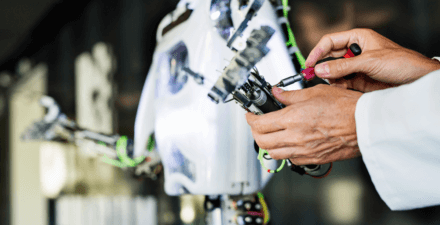Who profits from patents in the United States?

Overview
In standard competitive models of the labor market, we think of firms as price takers. That is, workers are paid a wage that is a function of their skill level, and firms take the market-level prices of skills as given. Yet in practice, there is growing empirical evidence that firms contribute substantially to wage inequality across identically skilled workers. Put simply, how much you earn seems to depend in part on the firm at which you work as opposed to depending solely on your own skills.
One natural explanation for this is that the performance of firms matters for what they pay their workers—in the sense that workers employed at firms that are doing better might earn more. But economic research aimed at testing for causal evidence on whether firm performance matters for worker pay has been challenging for two reasons. First, from an empirical perspective, researchers would ideally isolate clear shocks to firm performance and then trace through how those shocks propagate into worker pay. Although that thought experiment is simple enough to describe, nearly all past attempts to analyze this question have instead analyzed observed fluctuations in firm performance over time but without making an attempt to understand the source of these fluctuations.
Second, in the small number of cases where researchers have successfully identified clear shocks, researchers have lacked the type of detailed panel data needed to cleanly analyze wage responses among incumbent workers.1 That type of panel data is critical because the composition of workers employed at a firm may change in response to firm-level shocks. More specifically, when a firm discovers a new invention, it may hire more skilled workers in order to develop and market that invention. Average wages at the firm would then go up, but that could solely reflect a compositional change in the average skill level of workers employed at the firm—even if no “rents” (economic parlance for profits above the cost of production plus a reasonable return for the firm) from the innovation were actually being passed through to workers’ wages.
Worker-level panel data is needed in order to test whether the pay of incumbent workers actually changes in response to firm-level shocks. This column summarizes a recent academic paper that I wrote with my co-authors Patrick Kline at the University of California, Berkeley, Neviana Petkova at the U.S. Department of Treasury, and Owen Zidar at Princeton University, in which we try to make progress on answering this question by investigating how the granting of patents affects the performance of firms and their workers’ wage compensation using a new linkage of U.S. patent applications to U.S. Treasury business and worker tax records.
Briefly, our research paper documents some of the first evidence that, at least among among small, innovative firms, the increased profits derived from a patent do partially accrue to firms’ workers in the form of higher wages, though the bulk of those shared profits are returned as higher wages to employees at the top of these firms’ earnings distributions. Our interpretation is that firms choose to share profits with these workers because they would be costly for the firm to replace. How we gathered this evidence and arrived at these findings are detailed below.
Empirical approach: Comparing accepted and rejected patent applications
Patents provide firms with a temporary period of market power, during which they can charge supracompetitive prices and earn rents that allow them to recoup the fixed costs of their research investments. In our academic paper, we try to isolate quasi-random variation in which firms receive patents and to then leverage that variation in order to look at how patent-induced rents propagate into worker wages.
Specifically, consider the following thought experiment. Take two patent applications submitted by two separate firms to the U.S. Patent and Trademark Office in the same year, covering the same general type of technology. (In USPTO parlance, the two patent applications are sufficiently similar that they will be reviewed in the same Art Unit, or specialized group of USPTO examiners). One of the two applications is initially allowed—that is, it is granted on the first round of review. The other application is initially rejected. Under some assumptions, researchers can use firms that had patent applications initially rejected as a counterfactual for what would have happened to the outcomes for firms and workers at firms where patents were initially allowed, had the patent (counter-to-fact) not been granted.
Of course, it isn’t clear whether this thought experiment offers a clean comparison. It may be that better patent applications are more likely to be granted patents, in which case firms with patents that were initially rejected might not be a good comparison for firms with patents that were initially accepted. In practice, past research has documented a potentially large idiosyncratic component to patent grants—namely, that there is variation across (quasi-randomly assigned) patent examiners in their likelihood of granting patents based on observable similar applications, implying that some firms have their patent application granted because they were “lucky” in being assigned to a lenient patent examiner. 2
More directly relevant to our new paper, however, is our ability to assess empirically whether firms with patents that were initially accepted and firms with patents that were initially rejected look similar in terms of the levels and trends in their outcomes in the years prior to patent applications being submitted. What we find is that they do, lending credibility to this empirical approach.
The data we used
Our empirical analysis relies on a new linkage of two datasets. The first dataset is the census of published patent applications submitted to the U.S. Patent and Trademark Office between roughly 2001 and 2011. The second dataset is the universe of U.S. Treasury business tax filings and worker earnings histories drawn from W2 and 1099 tax filings.
In the United States, we are able to observe both accepted and rejected patent applications filed since November 29, 2000 under the American Inventors Protection Act. This data is what enables us to analyze the thought experiment described above since we can observe all firms filing for patent applications, including those firms granted patents, as well as those firms not granted patents. In practice, constructing this data on U.S. patent application filings is complicated because it requires stitching together several different USPTO administrative datasets. But in the end, we are able to combine several different public use files from the USPTO in order to construct a comprehensive dataset on patent applications filed over this time period, including information on the timing and content of the USPTO’s initial decision on each application, which is what we need in order to implement our empirical analysis.
We link the firms applying for patents (the so-called patent assignees) with firm names in the U.S. Treasury business tax filings (form 1120 for C corporations, 1120S for S corporations, and form 1065 for partnerships). The business tax filings data offer a high-quality set of firm-level variables, from which we are able to construct multiple measures of firm performance. We then link these business tax filings with worker-level W2 and 1099 filings in order to measure the number of employees and independent contractors, as well as various worker compensation measures. Of particular value for this analysis, the combination of the business and worker tax filings provides a window into compensation outcomes for many different types of workers, including firm officers and owners, who prevail at the top of the income distribution.3
Identifying valuable patents
It is well-known that most patents generate little actual value to the firm.4 In our context, this means that considering the full universe of patent grants would provide very little insight into the relationship between firm-level outcomes and worker-level earnings since most patent grants generate no shifts in firm-level outcomes. With that concern in mind, we designed our analysis to focus—in two ways—on a subsample of valuable patents that we expect to generate meaningful shifts in firm outcomes at the time the patents are initially allowed.
First, following the work of economists Joan Farre-Mensa at Northeastern University’s D’Amore-McKim School of Business, Deepak Hegde at New York University’s Stern School of Business, and Alexander Ljungqvist at the Stockholm School of Economics, we restrict our analysis to firms applying for a patent for the first time, for which patent decisions are likely to be most consequential.5 Second, among this sample of first-time applicants, we build on the analysis developed by Leonid Kogan at Massachusetts Institute of Technology’s Sloan School of Management, Dimitris Papanikolaou at Northwestern University’s Kellogg School of Management, Amit Suru at Stanford University’s Graduate School of Business, and Noah Stoffman at Indiana University’s Kelley School of Business to identify a subsample of predictably valuable patents.6
Kogan and his co-authors use so-called event studies to estimate the excess stock market return realized on the grant date of U.S. patents assigned to publicly traded firms. We develop a methodology for extrapolating from their estimates the value of patents for both nonpublicly traded firms in our sample and for firms whose patent applications are never granted. Specifically, we use characteristics of firms and their patent applications that are fixed at the time of application as the basis for extrapolating patent values. (Please see our working paper for a detailed description of this methodology.)
What we find, as expected (and comfortingly so, from the perspective of validating our empirical approach), is that low-value patents induce essentially no changes in outcomes for either firms or their workers. In contrast, high-value patents have larger, statistically significant effects on outcomes for both firms and workers.
We also document that firms with patent applications that are initially allowed exhibit similar trends in outcomes for firms and workers to those whose patent applications are initially rejected in years prior to the initial decision. In contrast, surplus per worker (where surplus is, roughly, profits plus the wage bill) rises differentially for firms with high-value patent applications that are initially allowed after the initial decision date, and those profits remain elevated afterward. Similar, although more muted, trends are observed for higher wages per worker.
The ratio of these two impacts is roughly one-third. That ratio can be interpreted as implying that workers capture roughly 30 cents of every dollar of patent-induced surplus in the form of higher earnings. Yet those higher earnings are not distributed evenly across the workforces of these firms. Our paper documents evidence that, although average earnings at these firms increase, patents exacerbate within-firm inequality on a variety of margins. In particular, we document that earnings increases are concentrated among employees in the top quartile of the within-firm earnings distribution and among employees listed on firm tax returns as “firm officers.”
Similarly, the earnings of owner-operators rise more than the earnings of other employees. And the earnings of male employees rise strongly in response to a patent allowance, while earnings of female employees are less responsive. Inventor earnings—defined as the earnings of employees ever listed as inventors on a patent application 7—are more responsive than are the earnings of noninventors, although we document substantial wage changes even for noninventors.
Conclusion
Our paper interprets this set of empirical findings in the context of a simple economic model in which incumbent workers—that is, workers who were present at the firm at the time the patent application was filed—are imperfectly substitutable with new hires. We think this economic model appropriately captures the features of the small, innovative firms we study because the innovative work conducted at these firms is necessarily specialized and proprietary in nature, which probably makes it costly to replace incumbent employees with new hires. In this model, firms choose to share economic rents with incumbent workers in order to increase the odds of retaining them. We document empirical results consistent with that prediction—namely, that worker retention rises most strongly among groups of workers with the largest earnings increases.
More broadly, our empirical findings provide some of the first evidence that truly idiosyncratic variability in the performance of firms is an important causal determinant of worker pay. Given that firm productivity is highly variable and persistent, it is plausible that firm-specific shocks contribute substantially to permanent earnings inequality across identically skilled workers, at least among the types of small, innovative U.S. firms that we study.
End Notes
1. John Van Reenen, “The Creation and Capture of Rents: Wages and Innovation in a Panel of U.K. Companies,” Quarterly Journal of Economics 111 (1) (1996): 195–226.
2. Bhaven Sampat and Heidi Williams, “How Do Patents Affect Follow-on Innovation? Evidence from the Human Genome,” American Economic Review 109 (1) (2019
3. Matthew Smith and others, “Capitalists in the Twenty-First Century.” Working paper 25442 (National Bureau of Economic Research, 2019).
4. Ariel Pakes, “Patents as Options: Some Estimates of the Value of Holding European Patent Stocks,” Econometrica 54 (4) (1986): 755–784.
5. Joan Farre-Mensa, Deepak Hegde, and Alexander Ljungqvist, “What Is a Patent Worth? Evidence from the U.S. Patent ‘Lottery.’” Working Paper 23268 (National Bureau of Economic Research, 2017).
6. Leonid Kogan and others, “Technological Innovation, Resource Allocation, and Growth,” Quarterly Journal of Economics 132 (2) (2017): 665–712.
7. Alex Bell and others, “Who Becomes an Inventor in America? The Importance of Exposure to Innovation,” Quarterly Journal of Economics, forthcoming.




